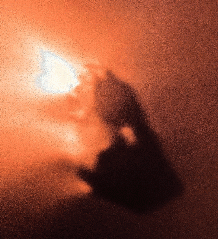 |
 |
|
| Nucleus | Comet | Jewitt |
|---|
| Excitation of Spectral Lines |
|---|
Excitation of Spectral Lines
Spectral lines are emitted at optical wavelengths through "resonance fluorescence". Photons from the sun are absorbed by an atom or "radical" (a piece of a molecule already photodissociated by a higher energy solar photon). The absorption causes an electron in the atom to jump to higher level from where, after a short delay, it falls back to its original level and emits a photon having the same energy as the one absorbed. Resonance fluorescence, grand as its name may sound, amounts to little more than a re-direction of a solar photon by the intervening atom, because the emission direction is random.
Photons are emitted at infrared wavelengths when molecules vibrate in response (usually) to thermal excitation.
Photons are emitted at submillimeter and millimeter wavelengths when molecules change the state of their rotation. The state of rotation is largely determined by the combined effects of thermal motions in the gas (communicated through collisions between molecules) and the absorption of photons from the sun.
Last updated December 1997 by David Jewitt
 |
 |
|
| Nucleus | Comet | Jewitt |
|---|